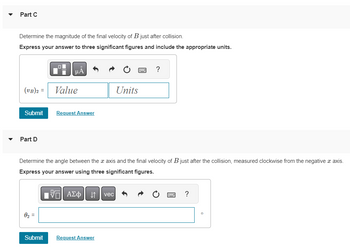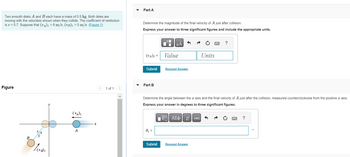
College Physics
11th Edition
ISBN: 9781305952300
Author: Raymond A. Serway, Chris Vuille
Publisher: Cengage Learning
expand_more
expand_more
format_list_bulleted
Topic Video
Question

Transcribed Image Text:Part C
Determine the magnitude of the final velocity of B just after collision.
Express your answer to three significant figures and include the appropriate units.
(VB)2 =
Submit
Part D
0₂=
HÅ
||
Value
Request Answer
Determine the angle between the x axis and the final velocity of B just after the collision, measured clockwise from the negative x axis.
Express your answer using three significant figures.
17 ΑΣΦ ↓↑ vec
Units
Submit Request Answer
?
X ?
0

Transcribed Image Text:Two smooth disks A and B each have a mass of 0.5 kg. Both disks are
moving with the velocities shown when they collide. The coefficient restitution
is e = 0.7. Suppose that (v₁)₁ = 6 m/s, (VB)₁ = 5 m/s. (Figure 1)
Figure
B
/ (VB) 1
(VA)₁
A
1 of 1 >
Part A
Determine the magnitude of the final velocity of A just after collision.
Express your answer to three significant figures and include the appropriate units.
(VA)2 =
Submit
Part B
0₁ =
μA
Submit
Value
Request Answer
Determine the angle between the x axis and the final velocity of A just after the collision, measured counterclockwise from the positive x axis.
Express your answer in degrees to three significant figures.
17| ΑΣΦ 41 | vec
|
Units
Request Answer
?
wwwwww
P
?
0
Expert Solution
This question has been solved!
Explore an expertly crafted, step-by-step solution for a thorough understanding of key concepts.
This is a popular solution
Trending nowThis is a popular solution!
Step by stepSolved in 2 steps with 2 images

Knowledge Booster
Learn more about
Need a deep-dive on the concept behind this application? Look no further. Learn more about this topic, physics and related others by exploring similar questions and additional content below.Similar questions
- Jupiter's moon Io has active volcanoes (in fact, it is the most volcanically active body in the solar system) that eject material as high as 500 km (or even higher) above the surface. Io has a mass of 8.93×1022kg and a radius of 1821 km How high would this material go on earth if it were ejected with the same speed as on Io? (REarth = 6370 km, mEartg=5.96×1024kg) NOTE: Your answer suggests that you have assumed constant gravitational acceleration over the whole height of the ejected debris. Note that the gravitational field changes quite significantly over this height.arrow_forwardJust need Darrow_forwardAn 8.50 kg point mass and a 15.0 kg point mass are held in place 50.0 cm apart.A particle of mass m is released from a point between the two masses 12.0 cm from the 8.50 kg mass along the line connecting the two fixed masses. Part A Find the magnitude of the acceleration of the particle.arrow_forward
- A big boulder has a mass of 8.20t (metric tons) and rests at a coal mine site. The boulder is blown up with explosives into 3 parts, all the 3 parts move horizontally in the xy plane. The biggest part (mass 3.3 t) travels west at a speed of 3m/s. The second part (mass 2.7t) moves at 2m/s in a direction 25.0 degrees south of east. What is the speed and direction of the third boulder part?arrow_forwardJust need Darrow_forwardA 5.0 kg particle is moving with a velocity v(t) = (4.0î + 6.0tĵ) m/s. (Assume momentum is in kg · m/s, force is in newtons, and t is in seconds. Express your answers in vector form. Use the following as necessary: t. Do not include units in your answers.) What is the momentum (as a function of time) of this particle? What is the net force acting on this particle?arrow_forward
- A star of mass M = 1.81 x 1030kg is the origin of a coordinate system. A comet of mass m = 7.87 × 10¹2 kg is initially at location = 2.49 x 10¹5 mî +3.88 × 10¹¹mj. The comet is travelling with velocity 7 = 3.68 × 10³ (The input below will accept answers with no more than 1% variation from the correct value.) Using conservation of energy and of angular momentum, what is the comet's distance from the star at the instant it's closest, and what is the comet's speed? (Hint: Consider the direction of the velocity relative to the position when the comet is at its closest point.) ×108m |T|= V ×105 marrow_forwardThe experiment done in lab is repeated, using a ball that has unknown mass m. You plot your data in the form of f 2 versus M/L, with f in rev/s, M in kg, and L in m. Your data falls close to a straight line that has slope 6.69 m/(kg · s2). Use g = 9.80 m/s2 and calculate the mass m of the ball.arrow_forwardTwo friends are playing billiards at an arcade center. One guy hit the cue ball to strike at another ball where it is initially at rest. After the collision caused by the ball that was at rest, the cue ball moves at 2.50 m/s along a line making an angle e=14.0° with its original direction of motion and the second balI has a speed of 1.50 m/s. Find the answer for Part a,b and c. (Note: Both balls have the same mass.) Part A: Find the angle 0 between the direction of the motion of the second ball and the original direction of motion of the cue ball. Part B: Find the cue ball's original speed? Part C: Figure out whether kinetic energy is conserved?arrow_forward
- A baseball of mass m = 0.41 kg is spun vertically on a massless string of length L = 0.52 m. The string can only support a tension of Tmax = 10.8 N before it will break. Randomized Variables m = 0.41 kgL = 0.52 mTmax = 10.8 N a)What is the maximum possible speed of the ball at the top of the loop, in meters per second? b)What is the maximum possible speed of the ball at the bottom of the loop, in meters per second?arrow_forwardHandwritten solutions are strictly prohibited.arrow_forwardA meteoroid is moving towards a planet. It has mass m = 0.54×109 kg and speed v1 = 4.7×107 m/s at distance R1 = 1.6×107 m from the center of the planet. The radius of the planet is R = 0.78×107 m. The mass of the planet is M = 5.6×1025kg. There is no air around the planet. a)Enter an expression for the total energy E of the meteoroid at R, the surface of the planet, in terms of defined quantities and v, the meteoroid’s speed when it reaches the planet’s surface. Select from the variables below to write your expression. Note that all variables may not be required.α, β, θ, d, g, G, h, m, M, P, R, R1, t, v, v1 b)Enter an expression for v, the meteoroid’s speed at the planet’s surface, in terms of G, M, v1, R1, and R. c)Calculate the value of v in meters per second.arrow_forward
arrow_back_ios
SEE MORE QUESTIONS
arrow_forward_ios
Recommended textbooks for you
 College PhysicsPhysicsISBN:9781305952300Author:Raymond A. Serway, Chris VuillePublisher:Cengage Learning
College PhysicsPhysicsISBN:9781305952300Author:Raymond A. Serway, Chris VuillePublisher:Cengage Learning University Physics (14th Edition)PhysicsISBN:9780133969290Author:Hugh D. Young, Roger A. FreedmanPublisher:PEARSON
University Physics (14th Edition)PhysicsISBN:9780133969290Author:Hugh D. Young, Roger A. FreedmanPublisher:PEARSON Introduction To Quantum MechanicsPhysicsISBN:9781107189638Author:Griffiths, David J., Schroeter, Darrell F.Publisher:Cambridge University Press
Introduction To Quantum MechanicsPhysicsISBN:9781107189638Author:Griffiths, David J., Schroeter, Darrell F.Publisher:Cambridge University Press Physics for Scientists and EngineersPhysicsISBN:9781337553278Author:Raymond A. Serway, John W. JewettPublisher:Cengage Learning
Physics for Scientists and EngineersPhysicsISBN:9781337553278Author:Raymond A. Serway, John W. JewettPublisher:Cengage Learning Lecture- Tutorials for Introductory AstronomyPhysicsISBN:9780321820464Author:Edward E. Prather, Tim P. Slater, Jeff P. Adams, Gina BrissendenPublisher:Addison-Wesley
Lecture- Tutorials for Introductory AstronomyPhysicsISBN:9780321820464Author:Edward E. Prather, Tim P. Slater, Jeff P. Adams, Gina BrissendenPublisher:Addison-Wesley College Physics: A Strategic Approach (4th Editio...PhysicsISBN:9780134609034Author:Randall D. Knight (Professor Emeritus), Brian Jones, Stuart FieldPublisher:PEARSON
College Physics: A Strategic Approach (4th Editio...PhysicsISBN:9780134609034Author:Randall D. Knight (Professor Emeritus), Brian Jones, Stuart FieldPublisher:PEARSON

College Physics
Physics
ISBN:9781305952300
Author:Raymond A. Serway, Chris Vuille
Publisher:Cengage Learning

University Physics (14th Edition)
Physics
ISBN:9780133969290
Author:Hugh D. Young, Roger A. Freedman
Publisher:PEARSON

Introduction To Quantum Mechanics
Physics
ISBN:9781107189638
Author:Griffiths, David J., Schroeter, Darrell F.
Publisher:Cambridge University Press

Physics for Scientists and Engineers
Physics
ISBN:9781337553278
Author:Raymond A. Serway, John W. Jewett
Publisher:Cengage Learning

Lecture- Tutorials for Introductory Astronomy
Physics
ISBN:9780321820464
Author:Edward E. Prather, Tim P. Slater, Jeff P. Adams, Gina Brissenden
Publisher:Addison-Wesley

College Physics: A Strategic Approach (4th Editio...
Physics
ISBN:9780134609034
Author:Randall D. Knight (Professor Emeritus), Brian Jones, Stuart Field
Publisher:PEARSON